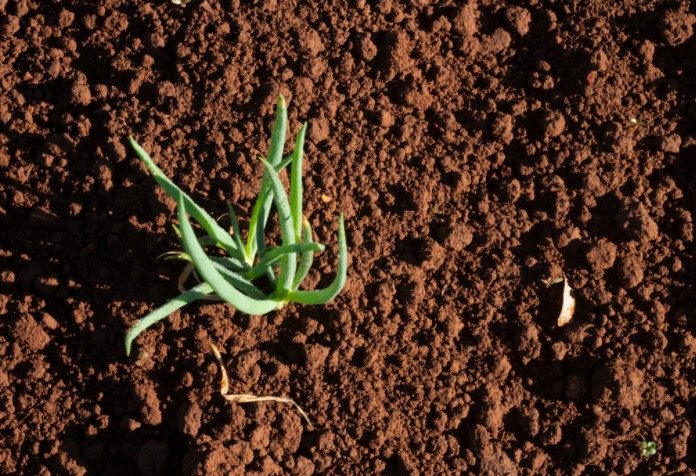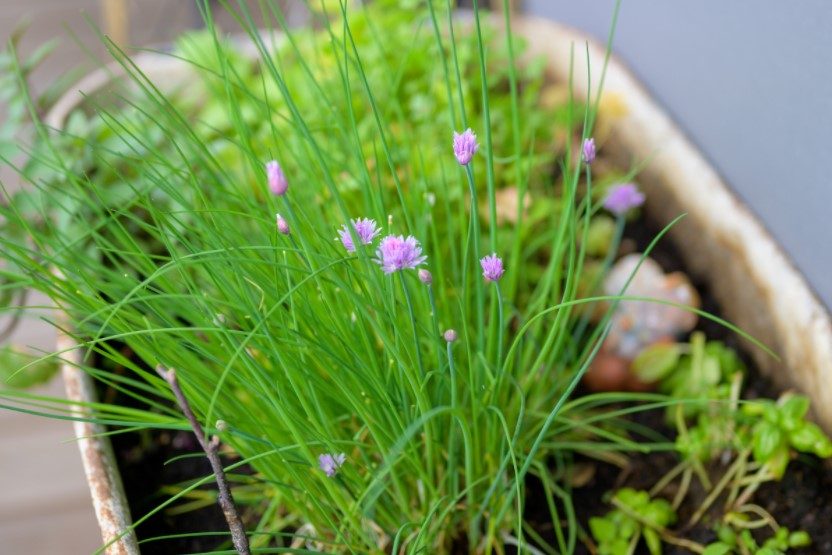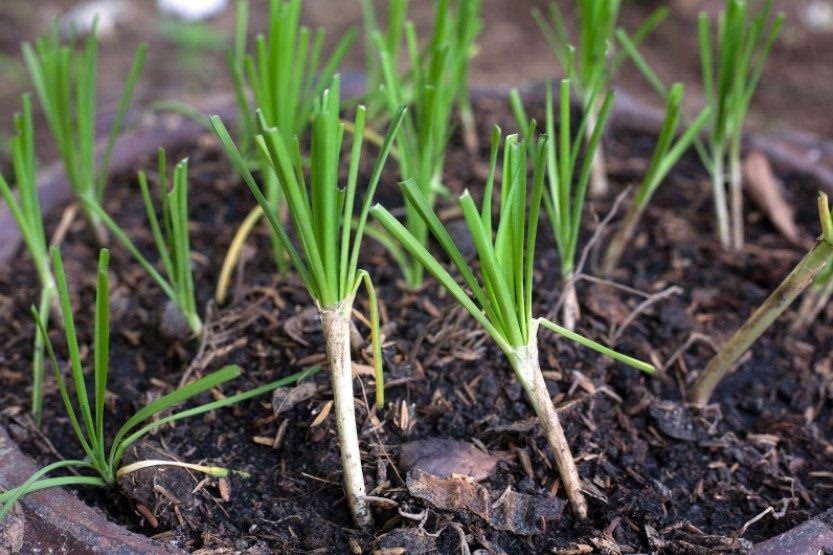Chives are perennial herb plants in Liliaceae (the lily family), related to leeks, onions, scallion, garlic, and shallot. How to grow chives, and why you grow them?
Not to be exaggerating, but Chives are the easiest and the most versatile plant to grow and maintain. I would highly recommend chives to anyone new to gardening.
Characteristics of Chives

Chives are mainly grown for culinary uses as all parts of the plant are edible. They are one of the fine herbs traditionally combined with tarragon, parsley, and chervil to flavor vegetables, salads, omelets, fish, chicken, and soups.
This hardy, drought-tolerant perennial sprouts from underground bulbs with a height of about 8-20 inches. The bulbs will split over time and form new bulbs, gradually forming a larger clump of chives.
Each fall, the bulbs beneath the soil go dormant, and the foliage of the plant dies. When the weather warms up in the spring, the bulbs start sprouting fresh green spiky foliage. In summer, you can see their pretty light purple blossoms.
They can add color to your garden, also make good companion plants, beneficial to suppress grass, and act as an insect attractor, which makes them an outstanding choice for permaculture gardening.
Chives can be grown in a clump or in a row to create an appealing garden edging. They even make a lovely porch or patio container herb!
Varieties of Chives

Chives prefer full sun and well-draining soil, but they still withstand partial shade and low soil conditions.
Take a note, here are four common varieties of chives you need to know (each of them has different flavors):
1. Common chives
They have an onion-like flavor and are popular in salads and soups. Common chives have dark green, thin and hollow foliage with a height of about 10-12 inches.
Beautiful lavender-colored flowers bloom on stems that grow on top of the foliage through the early month of summer. Seed and division propagation are the most common method on how to grow chives.
2. Giant Siberian chives
They have a strong onion-garlic flavor which is claimed to be richer than the taste of all other chives varieties.
Taller than common chives, but they look pretty similar. The sap from the leaves of Giant Siberian chives can repel moths or other insects.
3. Garlic chives
Widely used in the delicious Asian cuisine with onion-garlic taste, you may find them in different names; Chinese leeks, geisha garlic chives, or Chinese chives.
The plant can reach a height of up to 24 inches and has flat grass-like foliage. Blossoms are florets with a white star-shaped outline that bloom in the late summer to early fall.
4. Siberian garlic chives
Much like other varieties of chives, Siberian garlic chives have an onion-garlic flavor. They have blue-green foliage, thus also called ‘blue chives’, while blossoms are pink that arise in midsummer.
During the winter, you can grow them indoors by simply placing them where they’ll get direct sunlight. If you prefer to plant them outdoors, they pair nicely with chamomile, beets, tomatoes, and carrots.
How to Grow Chives
If you’re looking for ideas to grow chives in your garden, here are some that may inspire you:
1. How to Grow Chives from Seed
- Fill the container with seed-starter potting soil mix and add all-purpose fertilizer (2-3 tablespoons per square foot of planting area).
- Make sure the soil is moist, fertile, and well-draining with a pH of 6.0 to 7.0.
- Make rows 1/2-inch deep, then scatter the seeds in the rows and lightly cover them with the soil mixture.
- Place the container in a bright area and indirect light, keep the temperatures at 15 to 21 degrees Celcius.
- Use room temperature water to mist them.
- After four to six weeks, you can plant the young plants outside in 6 inches apart rows.
- Prepare yourself in patience if you prefer this method. To grow to full size, they need to take up to two years. This is why people usually avoid planting chives from seeds.
2. How to Grow Chives from Divisions
- Dig the clump gently and take a smaller clump away from the main clump. At least five to ten bulbs should be present in the smaller clump.
- Transplant them to the location you desired to grow chives.
- To promote proper leaf growth, pinch back faded blooms frequently.
- Divide the clumps every three to four years after flowering to prevent overcrowding.
How to Care for Chives
When it comes to chives, there are a few things to keep in mind:
- Chives grow best in at least 6 hours in a full sun area in fertile and well-drained soil. If the full sun isn’t available as an option, worry not. You can settle for partial sun.
- Keep them well-watered, particularly in hot weather.
- Since they are perennial plants, chives will die back in the winter and regrow when spring has arrived. Every couple of years, divide and repot chives that have been grown in pots.
- While chives that grow in the ground may become clogged as well, congested clumps can be rejuvenated by lifting and dividing them. Place the divisions in the ground to start new chive plants, or simply pass them on to friends or neighbors!
How to Harvest Chives

To master how to grow chives, you need to know how to harvesting too; it’s as easy as growing them.
- Begin harvesting your plant about 60 days after seeding or 30 days after they were transplanted.
- Make sure you cut the leaves down to their base, approximately within 1-2 inches of the soil.
- During the first year, harvest three or four times. Plants should be pruned monthly in the following years.
- Blossoms arise full and bright in late spring to early summer. They are edible and taste the best right after they’ve opened.
How to Store Chives
Chives are best to use when they are fresh. Keep them in a resealable container in a cool place.
You can also keep the leaves in an airtight bag then store them in the freezer to use later (the quality should be maintained for 4-6 months). Avoid to dried the chives as they may lose the flavor.
FAQ – How to Grow Chives
When can I plant chives?
Chives are typically planted in the spring, but they can germinate in temperatures as low as 45°F and as high as 95°F (7-35 degrees Celsius). To get a head start on the growing season, start them indoors 8-10 weeks before the last expected spring frost.
Rather than growing chives from seeds, most sources suggest starting with a store-bought plant and propagating by dividing.
How far apart should I plant chives?
For best results, you need to allow at least 4-6 inches of space for each plant.
How long my chives seeds will take time to sprout?
It can take anywhere from 7 to 21 days for chive seeds to germinate.
What type of soil can I use to grow chives?
Chives can thrive in a variety of conditions. Before sowing or transplanting, it is highly recommended to apply compost to the soil.
Can I use a container to grow chives?
Yes, the container should be at least 6 inches deep for better performance. However, since container soil dries out easily, they’ll need to be watered more regularly.
Can I grow my chives in the shade?
Yes. Chives need only 3 to 6 hours per day to be under full sun. So, you can grow them in partial shade too.
How to grow chives if indoors is the option?
You can grow chives in a pot indoors on a sunny windowsill and harvest them year-round. If you choose to grow chives outdoors during the warmer months, simply pull up the clump, transplant it to a container, and carry the chives indoors for the winter to continue harvesting.
Is it necessary to fertilize my chives?
Chives rarely require fertilization. However, if the soil is severely deficient in nutrients, adding a small amount of nitrogen-rich compost or fertilizer will help.
What ongoing care should I do on how to grow chives properly?
Chives are low-maintenance plants. Simply harvest the plants regularly to keep them vigorous and promote them to spread, water every time the soil dry, and divide the plants frequently every 2 to 5 years in the spring or fall.
Also, the leaf’s growth can be better if the flowers are removed as soon as they appear.
How do I save seeds for chives?
You need to wait until the flowers dry to then crumbling them so the seeds will be released. A cool, dry, and dark place is the best storage for your chives seeds (they should last up to 3 years).
How do I cook chives?
You can simply chop raw chives into salads or soups. They also add an excellent taste in sandwiches, scrambled eggs, oils, and spreads. Their fresh flowers can be used in salads or the preparation of flavorful pink vinegar.
So, now you know how to grow chives. Not only are they low maintenance, but also an outstanding addition to many savory dishes!
